3COM NBX 3101, NBX 3102 User Manual

NBX® Telephone Guide
Telephones
■NBX 3102 Business Telephone
■NBX 2102 Business Telephone
■NBX 2102-IR Business Telephone
■NBX 1102 Business Telephone
■NBX 3101 Basic Telephone
■NBX 3101SP Basic Telephone
■NBX 2101 Basic Telephone
Attendant Consoles
■NBX 3105 Attendant Console
■NBX 1105 Attendant Console
■NBX Complement Attendant Software
http://www.3com.com/
PhG-EN 02-2004
3Com Corporation, 350 Campus Drive, Marlborough, MA 01752-3046
Copyright © 2004, 3Com Corporation. All rights reserved. No part of this documentation may be reproduced in any form or by any means or used to make any derivative work (such as translation, transformation, or adaptation) without written permission from 3Com Corporation.
3Com Corporation reserves the right to revise this documentation and to make changes in content from time to time without obligation on the part of 3Com Corporation to provide notification of such revision or change.
3Com Corporation provides this documentation without warranty, term, or condition of any kind, either implied or expressed, including, but not limited to, the implied warranties, terms, or conditions of merchantability, satisfactory quality, and fitness for a particular purpose. 3Com may make improvements or changes in the product(s) and/or the program(s) described in this documentation at any time.
If there is any software on removable media described in this documentation, it is furnished under a license agreement included with the product as a separate document, in the hardcopy documentation, or on the removable media in a directory file named LICENSE.TXT or !LICENSE.TXT. If you are unable to locate a copy, please contact 3Com and a copy will be provided to you.
UNITED STATES GOVERNMENT LEGEND
If you are a United States government agency, then this documentation and the software described herein are provided to you subject to the following:
All technical data and computer software are commercial in nature and developed solely at private expense. Software is delivered as “Commercial Computer Software” as defined in DFARS 252.227-7014 (June 1995) or as a “commercial item” as defined in FAR 2.101(a) and as such is provided with only such rights as are provided in 3Com’s standard commercial license for the Software. Technical data is provided with limited rights only as provided in DFAR 252.227-7015 (Nov 1995) or FAR 52.227-14 (June 1987), whichever is applicable. You agree not to remove or deface any portion of any legend provided on any licensed program or documentation contained in, or delivered to you in conjunction with, this guide.
Unless otherwise indicated, 3Com registered trademarks are registered in the United States and may or may not be registered in other countries.
3Com, NBX, the 3Com logo, and SuperStack are registered trademarks of 3Com Corporation. NBX NetSet and pcXset are trademarks of 3Com Corporation.
Adobe is a trademark and Adobe Acrobat is a registered trademark of Adobe Systems Incorporated. Microsoft, Windows, Windows 2000, and Windows NT are registered trademarks of Microsoft Corporation.
All other company and product names may be trademarks of the respective companies with which they are associated.

CONTENTS
ABOUT THIS GUIDE
|
How to Use This Guide |
9 |
|
|
|
|
Conventions 10 |
|
|
|
|
|
Documentation |
11 |
|
|
|
|
Comments on the Documentation 11 |
|
|||
|
|
|
|
|
|
1 GETTING STARTED |
|
|
|
||
|
Setting Up Your Password and Voice Mail for the First Time |
13 |
|||
|
NBX NetSet Utility |
15 |
|
|
|
|
Starting the NBX NetSet Utility |
15 |
|
||
|
Navigation and Shortcut Icons in the NBX NetSet Utility |
16 |
|||
|
Quick Reference Guides |
16 |
|
|
|
|
|
|
|||
2 NBX 3102 BUSINESS TELEPHONE |
|
||||
|
Telephone Buttons and Controls |
18 |
|
||
|
Programmable Access Buttons 21 |
|
|||
|
Status Lights for System Appearance Buttons 22 |
|
|||
3 NBX 1102, 2102, AND 2102-IR BUSINESS TELEPHONES
Telephone Buttons and Controls |
24 |
Programmable Access Buttons |
27 |
Status Lights for System Appearance Buttons 28
4 NBX 3101 AND 3101SP BASIC TELEPHONES
Telephone Buttons and Controls |
30 |
Programmable Access Buttons |
32 |
Status Lights for System Appearance Buttons 33

5 NBX 2101 BASIC TELEPHONE
|
Telephone Buttons and Controls |
36 |
|
|
|
Programmable Access Buttons |
38 |
|
|
|
Status Icons 38 |
|
|
|
|
|
|
|
|
6 NBX MESSAGING |
|
|
|
|
|
NBX Messaging Components |
40 |
|
|
|
Important Considerations |
40 |
|
|
|
Changing Your Password |
41 |
|
|
|
Security Tips 41 |
|
|
|
|
Changing Your Name Announcement and Personal Greeting 42 |
|||
|
Listening to NBX Messages 42 |
|
||
|
Message Indicators |
43 |
|
|
|
LIstening from Your Computer 43 |
|
||
|
LIstening from Your NBX Telephone |
44 |
||
|
Listening from Any Internal NBX Telephone 44 |
|||
|
Listening from an External Location |
44 |
||
|
Managing Your Messages |
45 |
|
|
|
Information About Your Messages |
45 |
||
|
Replying to a Message |
46 |
|
|
|
Forwarding a Message |
47 |
|
|
|
Creating and Sending a Message |
48 |
|
||
|
Creating Personal Voice Mail Group Lists |
49 |
|||
|
Modifying or Deleting Groups |
50 |
|
||
|
Marking a Message as Private or Urgent |
51 |
|||
|
Forwarding Incoming Calls to Your Call Coverage Point 51 |
||||
|
Other Ways to Manage Your Voice Mail Messages 52 |
||||
|
Other Kinds of Mailboxes |
52 |
|
|
|
|
Greeting-Only Mailbox |
52 |
|
|
|
|
Phantom Mailbox 53 |
|
|
|
|
|
Group Mailbox |
53 |
|
|
|
|
|
|
|
|
|
7 STANDARD FEATURES |
|
|
|
||
|
Answering a Call |
56 |
|
|
|
|
Caller ID 56 |
|
|
|
|
|
Answering a Second Call |
56 |
|
|
|
|
Using the NBX Telephone Display Panel |
57 |
|||

Tips on Using the Lists |
58 |
|
|
More Ways to Dial a Call |
59 |
|
|
An Internal Call |
59 |
|
|
An External Call |
59 |
|
|
Redialing a Call |
60 |
|
|
Setting Your Call Coverage Point |
60 |
||
Putting a Call on Hold 61 |
|
||
Dialing Another Call |
61 |
|
|
More Than One Call |
62 |
|
|
Transferring a Call |
63 |
|
|
Announced (Screened) Transfer |
64 |
||
Blind Transfer |
64 |
|
|
Direct Mail Transfer |
64 |
|
|
Establishing a Conference Call |
65 |
Disconnecting the Last Person That You Called 66 |
|
More About Conference Calls |
66 |
Setting the Volume 67 |
|
8 PERSONALIZING YOUR TELEPHONE
Guidelines About Features on NBX Telephones |
70 |
||||
Ringer Tones |
70 |
|
|
|
|
Speed Dials 70 |
|
|
|
|
|
Personal Speed Dials |
71 |
|
|
||
System-wide Speed Dials 72 |
|
|
|||
Special Case: One-Touch Speed Dials |
73 |
|
|||
Printing Speed Dial Lists and Labels |
74 |
|
|||
Off-Site Notification 75 |
|
|
|||
Do Not Disturb |
78 |
|
|
|
|
Preventing Unauthorized Use of Your Telephone |
79 |
||||
Telephone Locking |
80 |
|
|
||
Call Permissions |
80 |
|
|
|
|
Class of Service Override |
81 |
|
|
||
Using a Headset |
82 |
|
|
|
|
With the NBX 3102 Business Telephone 82 |
|
||||
General Headset Instructions 83 |
|
|
|||
Returning to the Headset After a Long Delay |
84 |
||||
Palm Integration |
84 |
|
|
|
|

9 GETTING MORE FROM YOUR TELEPHONE SYSTEM
Listening to Your Messages in Your E-mail or Browser 86 |
||||
Account (Billing) Codes |
86 |
|
||
Caller ID |
87 |
|
|
|
Internal and External Caller ID |
87 |
|||
Calling Line Identity Restriction (CLIR) 87 |
||||
Call Pickup |
88 |
|
|
|
Directed Call Pickup on a Specific Telephone 89 |
||||
Group Call Pickup |
89 |
|
||
Hunt Groups and Calling Groups |
89 |
|||
Hunt Groups |
90 |
|
|
|
Calling Groups |
92 |
|
||
Group Membership |
92 |
|
||
Call Park |
93 |
|
|
|
Paging 94 |
|
|
|
|
Dialing a Call to a Remote Office |
95 |
|||
Using Unique Extensions 95 |
|
|||
Using Site Codes |
96 |
|
||
Bridged Extensions |
97 |
|
||
Delayed Ringing |
97 |
|
|
|
Using Pulse Dialing |
98 |
|
||
|
Using a Feature Code |
98 |
|
||
|
Using a Mapped Button |
98 |
|
||
|
Using a Personal Speed Dial |
98 |
|||
|
Additional Applications |
99 |
|
|
|
10 |
|
||||
NBX 3105 AND 1105 ATTENDANT CONSOLES |
|||||
|
NBX Attendant Console |
102 |
|
||
|
Access Buttons |
102 |
|
|
|
|
Feature Buttons |
102 |
|
|
|
|
Attendant Console Labels |
105 |
|||
|
Complement Attendant Software |
106 |
|||
|
Managing Calls |
107 |
|
|
|
A |
|
||||
TELEPHONE INSTALLATION AND MAINTENANCE |
|||||
|
Connecting the Telephone |
|
109 |
|
|
|
Installing the 3102 Telephone Label Plate 111 |
||||
|
Attaching and Adjusting the 3101/3102/3105 Support Bracket 111 |
||||

Attaching and Adjusting the 1102/2101/2102 Support Bracket 113 Low-Profile and High-Profile Positions 113
Wall-Mount Position |
114 |
Security Wall-Mount Bracket 115 |
|
Opening the 3105 Attendant Console Label Cover 115 |
|
Moving Your Telephone |
115 |
Swapping Telephones 115 |
|
Cleaning Your Telephone |
116 |
Troubleshooting Problems |
116 |
INDEX

ABOUT THIS GUIDE
This guide is intended for anyone using NBX® Telephones, NBX Attendant Consoles, or the NBX Complement Attendant Software. It includes information about using the NBX Voice Mail system and the NBX NetSet™ administration utility for personal telephone settings.
If the information in the release notes (readme.pdf) on the NBX Resource Pack CD differs from the information in this guide, follow the instructions in the release notes.
Analog telephones connected through the Analog Terminal Card or the Analog Terminal Adapter can use most of the features described in this book. See the NBX Feature Codes Guide in the NBX NetSet utility.
How to Use |
Table 1 shows where to look for specific information in this guide. |
|
This Guide |
Table 1 Where to Find Information |
|
|
|
|
|
|
|
|
If you are looking for information about |
Turn to |
|
|
|
|
How to get started with your new telephone |
Chapter 1 |
|
|
|
|
The NBX 3102 Business Telephone |
Chapter 2 |
|
|
|
|
The NBX 1102, 2102, and 2102-IR Business Telephones |
Chapter 3 |
|
|
|
|
The NBX 3101 and 3101SP Basic Telephones |
Chapter 4 |
|
|
|
|
The NBX 2101 Basic Telephone |
Chapter 5 |
|
|
|
|
NBX Voice Messaging features |
Chapter 6 |
|
|
|
|
Using standard telephone features |
Chapter 7 |
|
|
|
|
Personalizing your telephone |
Chapter 8 |
|
|
|
|
Enhanced system features |
Chapter 9 |
|
|
|
|
The Attendant Console and Complement Attendant Software |
Chapter 10 |
|
|
|
|
Telephone maintenance and troubleshooting information |
Appendix A |
|
|
|
|
References to all topics in this book |
Index |
|
|
|
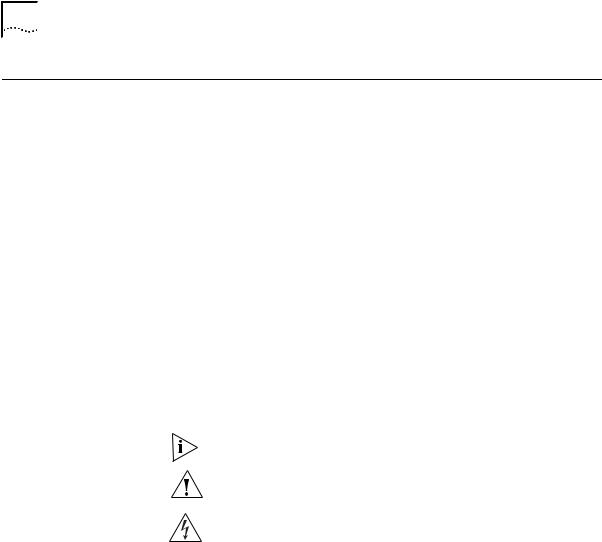
10 ABOUT THIS GUIDE
Conventions |
Table 2 defines some commonly used words and phrases in this guide. |
|
|
Table 2 Common Terms |
|
|
|
|
|
Term |
Definition |
|
|
|
|
Auto Attendant |
The set of voice prompts that answers incoming calls and |
|
|
describes actions that a caller or user can take to access |
|
|
individual services. |
|
|
|
|
Administrator |
The person who is responsible for maintaining your |
|
|
3Com Networked Telephony Solution. |
|
|
|
|
Receptionist |
The person who answers the majority of incoming |
|
|
telephone calls. In some business environments, this |
|
|
person may be a switchboard operator. |
|
|
|
|
User |
A person who has a single NBX Business Telephone, an |
|
|
NBX Basic Telephone, or an analog telephone connected |
|
|
to the NBX system through an ATC card or the |
|
|
single-port ATA device. |
|
|
|
Table 3 lists conventions that are used throughout this guide.
Table 3 |
Icons |
|
|
|
|
Icon |
Type |
Description |
|
|
|
|
Information note |
Information that describes important features |
|
|
or instructions. |
|
|
|
|
Caution |
Information that alerts you to potential loss of |
|
|
data or potential damage to an application, |
|
|
system, device, or network. |
|
|
|
|
Warning |
Information that alerts you to potential |
|
|
personal injury. |
|
|
|
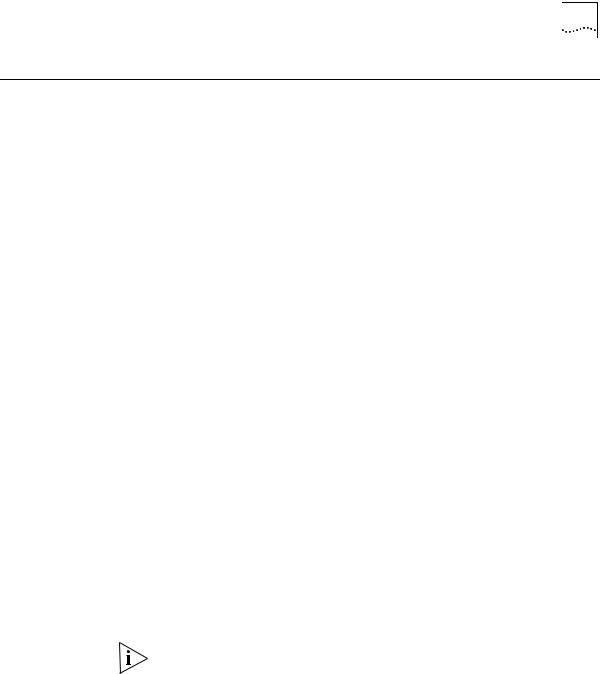
Documentation 11
Documentation |
The documentation set for 3Com NBX Networked Telephony Solutions is |
|
designed to help NBX telephone users, installers, and administrators |
|
maximize the full potential of the system. |
|
The NBX Resource Pack CD contains many guides to the NBX products |
|
and their related 3Com applications. |
|
When you log in to the NBX NetSet utility as a user, you can view the PDF |
|
versions of the NBX Telephone Guide and NBX Feature Codes Guide by |
|
clicking the icons at the bottom of the screen. An administrator who logs |
|
in can also see the NBX Installation Guide and the NBX Administrator’s |
|
Guide. The NBX NetSet utility also includes a searchable Help system with |
|
Help buttons on each screen. |
Comments on the |
Your suggestions are important to us. They help us to make the NBX |
Documentation |
documentation more useful to you. |
|
Please send your e-mail comments about this guide or any of the |
|
3Com NBX documentation and Help systems to: |
|
Voice_TechComm_Comments@3com.com |
Include the following information with your comments:
■Document title
■Document part number (found on the front or back page)
■Page number
Example:
NBX Telephone Guide
Part Number PhG-EN
Page 25
As always, please address all questions regarding the NBX hardware and software to your 3Com NBX Voice-Authorized Partner.

12 ABOUT THIS GUIDE
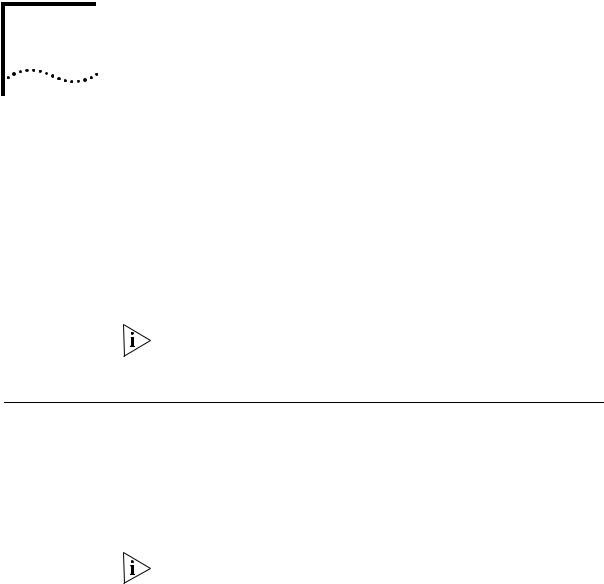
GETTING STARTED
1
As soon as you are given a telephone and extension number, you need to set up a password and record your name announcement and personal greeting.
This chapter covers these topics:
■Setting Up Your Password and Voice Mail for the First Time
■NBX NetSet Utility
■Quick Reference Guides
For how to access NBX features from an analog telephone, set your password as described next and then see the NBX Feature Codes Guide in the NBX NetSet utility.
Setting Up Your Password and Voice Mail
for the First Time
The procedure by which you set up your password and voice mailbox for the first time depends on:
■The kind of telephone that you have
■The kind of voice messaging system on your NBX system. Ask your administrator what kind of voice messaging is active on your system.
Table 4 describes how to set up your first password.
For details on tones and codes on analog telephones, see the NBX Feature Codes Guide in the NBX NetSet utility.

14 |
CHAPTER 1: GETTING STARTED |
|
|
|
|
|
|
|
|
||
Feature |
NBX Business Phones |
NBX Basic Phones |
Analog Telephones |
||
|
|
|
|
||
Password — Set Initially |
|
|
|
||
If your system uses NBX |
Msg button (1102, |
Msg button (2101) or |
500 ** and follow the |
||
Messaging, follow the NBX voice |
2102, 2102-IR) or |
button (3101 and |
voice prompts |
||
prompts to set your NBX password |
button (3102) and follow |
3101SP) and follow the |
|
||
(which is the same for NBX NetSet |
the voice prompts |
voice prompts |
|
||
and voice messaging) OR use the NBX |
|
|
|
||
NetSet utility, described next. |
|
|
|
||
If your system uses a voice |
OR, for systems that do |
OR, for systems that do |
OR, for systems that do |
||
messaging application other than |
not use NBX Messaging: |
not use NBX Messaging: not use NBX Messaging: |
|||
NBX Messaging, use this code |
Feature |
Feature |
# |
||
sequence to set your password for |
|||||
+ 434 |
+ 434 |
(Feature Entry Tone) |
|||
the NBX NetSet utility. 3Com |
|||||
+ new password |
+ new password |
+ 434 |
|||
recommends that you use the same |
|||||
+ # |
+ # |
(Feature Entry Tone) |
|||
password for the NBX NetSet utility |
|||||
+ repeat your new |
+ repeat your new |
+ new password |
|||
and your messaging application. |
|||||
password |
password |
+ # |
|||
|
|
||||
For all voice messaging systems: |
+ # |
+ # |
(Feature Entry Tone) |
||
■ Use only 4- to 10-digit numbers |
|
|
+ repeat your new |
||
|
|
password |
|||
|
|
|
|
||
■ Do not use letters, *, or # as part |
|
|
+ # |
||
of your password. |
|
|
(Confirmation Tone) |
||
|
|
|
|
||
Password — Change |
|
|
|
||
If your system uses NBX |
Msg button (1102, |
Msg button (2101) or |
500 ** |
||
Messaging, follow the NBX voice |
2102, 2102-IR) or |
button (3101 and |
+ extension number |
||
prompts to change your NBX |
button (3102) |
3101SP) |
+ current password |
||
password (which changes your NBX |
+ current password |
+ current password |
+ # |
||
NetSet password, because they are |
+ # |
+ # |
+ 9 |
||
the same) OR use the NBX NetSet |
+ 9 |
+ 9 |
+ 2 |
||
utility, described next. |
+ 2 |
+ 2 |
+ follow the prompts |
||
If your system uses a voice |
+ follow the prompts |
+ follow the prompts |
|
||
|
|
|
|||
messaging application other than |
OR, for systems that do |
OR, for systems that do |
OR, for systems that do |
||
NBX Messaging, use this code |
not use NBX Messaging: |
not use NBX Messaging: not use NBX Messaging: |
|||
sequence to change your password |
Feature |
Feature |
# |
||
for the NBX NetSet utility. 3Com |
|||||
+ 434 |
+ 434 |
(Feature Entry Tone) |
|||
recommends that you use the same |
|||||
+ current password |
+ current password |
+ 434 |
|||
password for the NBX NetSet utility |
|||||
+ # |
+ # |
(Feature Entry Tone) |
|||
and your voice messaging application. |
|||||
|
|
+ new password |
+ new password |
+ current password |
|
For all voice messaging systems: |
+ # |
+ # |
+ # |
||
■ If you forget your password, the |
+ repeat your new |
+ repeat your new |
(Feature Entry Tone) |
||
password |
password |
+ new password |
|||
administrator can reset it to your |
|||||
|
|
|
|||
Table 4 Setting Your NBX NetSet and NBX Messaging Password |
+ # |
|
|
||
extension. Then use this code (for |
(Feature Entry Tone) |
|
applications other than NBX |
||
+ repeat your new |
||
Messaging) or the NBX voice |
||
password |
||
prompts to change it. |
||
+ # |
||
|
||
|
(Confirmation Tone) |
|
|
|
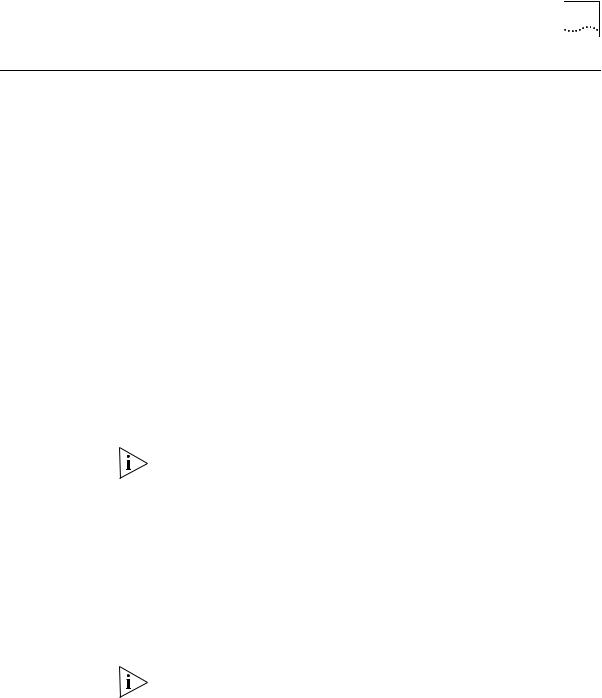
NBX NetSet Utility 15
NBX NetSet Utility The NBX NetSet administration utility has two interfaces:
■Administrator — Your administrator logs in with a special password and uses the NBX NetSet utility to manage and configure system-wide telephone settings and many of the settings for your telephone.
■User — As a telephone user, you log in to the NBX NetSet utility with your own system ID (your extension) and password to:
■View and change your telephone’s personal settings, such as speed dials, ringer tone, and specify where you want your calls to go when you cannot answer them (your call coverage point).
■Listen to and delete your voice messages from your computer as an alternative to managing calls on your telephone.
■View your call permissions, certain current feature settings, and the internal user directory to call other users on your system.
■Log in to and out of one or all hunt groups and calling groups of which your telephone is a member.
See Chapter 7, Chapter 8, and Chapter 9 for discussions about the standard and enhanced features that you can monitor and change in the NBX NetSet utility. See Chapter 6 for voice messaging features.
If your NBX system uses a messaging application other than NBX Messaging, off-site notification and other voice messaging features are available through your messaging application. See the application’s documentation rather than using this Guide.
Starting the NBX To use the NBX NetSet utility, you need a computer that is connected to NetSet Utility your local area network (LAN) and that has a web browser. (You do not
need Internet access.) To start the NBX NetSet utility:
1Ask your administrator for the IP (web) address for your NBX system. In the web browser on your computer (Microsoft Internet Explorer version 5.5 or later is optimal), enter the IP address in the Address field, and then press Enter on your keyboard. The NBX NetSet login screen appears.
You cannot log in to the NBX NetSet utility until you establish your password through your telephone using NBX voice prompts or the Feature Code sequence. See Table 4.
2 Click User to log in as a user. The password dialog box appears.
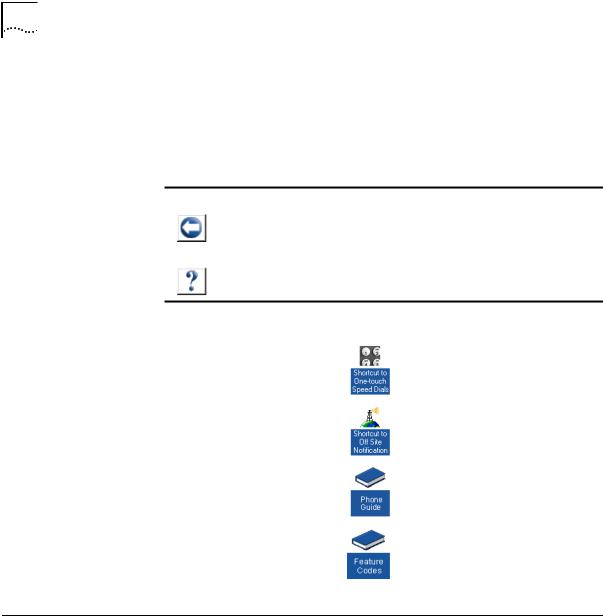
16 CHAPTER 1: GETTING STARTED
Navigation and
Shortcut Icons
in the NBX NetSet
Utility
3Type your NBX NetSet user identification (always your 3-digit or 4-digit telephone extension) and your NBX NetSet password, and then click OK.
The icons at the lower right of any Personal Settings window allow you or your administrator to navigate to the following features:
Table 5 Navigation Icons
Icon |
Action |
Where You Go |
|
|
|
|
|
|
Back |
■ |
For the User goes to the main NBX NetSet login dialog box |
|
|
■ |
For the Administrator goes to the NBX NetSet main menu |
|
|
|
window |
|
Help |
Help for the fields and procedures related to the screen |
|
Click the icons below the window to go directly to these features:
One-Touch Speed Dials
Off-Site Notification
Telephone Guide (this guide)
NBX Feature Codes Guide
Quick Reference |
To open and print a copy of the Quick Reference Guides for the most |
Guides |
frequently used features on your telephone: |
1Log in to the NBX NetSet utility. See “Starting the NBX NetSet Utility” earlier in this chapter.
2Click Telephone Quick Reference. The quick reference that pertains to your telephone (Business, Basic, or analog) appears. Adobe Acrobat Reader 4.0 or higher is required to view the file. Adobe Acrobat Reader is available free from the Adobe Web site: www.adobe.com
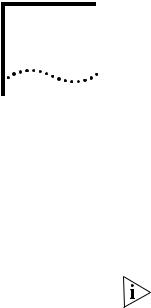
NBX 3102
2 BUSINESS TELEPHONE
This chapter describes the buttons, controls, and features on the NBX 3102 Business Telephone. It covers these topics:
■Telephone Buttons and Controls
■Programmable Access Buttons
■Status Lights for System Appearance Buttons
For a description of the features on the NBX 1102, 2102, and 2102-IR
Business Telephones, see Chapter 3.
For a description of the features on the NBX 3101 and 3101SP Basic
Telephones, see Chapter 4.
For a description of the features on the NBX 2101 Basic Telephone, see
Chapter 5.
For how these features work on an analog telephone that is connected to the NBX system, click the NBX Feature Codes Guide icon below any screen in the NBX NetSet utility.
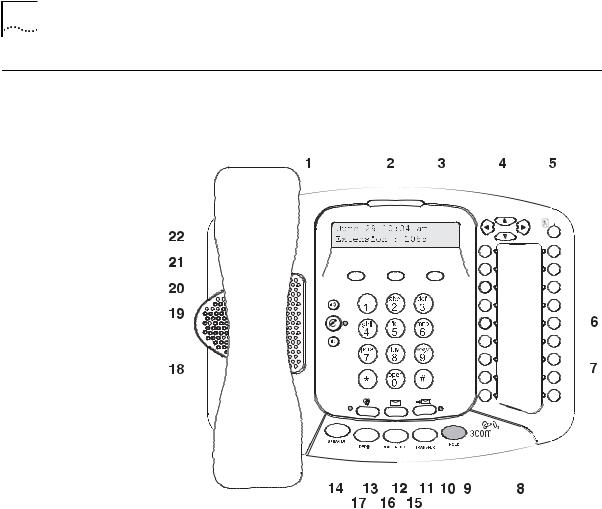
18 CHAPTER 2: NBX 3102 BUSINESS TELEPHONE
Telephone Buttons |
Figure 1 shows the buttons and controls on the NBX 3102 Business |
|
|
|||||||||||||||||||||||||||||||||
and Controls |
Telephone. The features are discussed after the picture. |
|
|
|||||||||||||||||||||||||||||||||
|
Figure 1 NBX 3102 Business Telephone |
|
|
|||||||||||||||||||||||||||||||||
|
|
|
|
|
|
|
|
|
|
|
|
|
|
|
|
|
|
|
|
|
|
|
|
|
|
|
|
|
|
|
|
|
|
|
|
|
|
|
|
|
|
|
|
|
|
|
|
|
|
|
|
|
|
|
|
|
|
|
|
|
|
|
|
|
|
|
|
|
|
|
|
|
|
|
|
|
|
|
|
|
|
|
|
|
|
|
|
|
|
|
|
|
|
|
|
|
|
|
|
|
|
|
|
|
|
|
|
|
|
|
|
|
|
|
|
|
|
|
|
|
|
|
|
|
|
|
|
|
|
|
|
|
|
|
|
|
|
|
|
|
|
|
|
|
|
|
|
|
|
|
|
|
|
|
|
|
|
|
|
|
|
|
|
|
|
|
|
|
|
|
|
|
|
|
|
|
|
|
|
|
|
|
|
|
|
|
|
|
|
|
|
|
|
|
|
|
|
|
|
|
|
|
|
|
|
|
|
|
|
|
|
|
|
|
|
|
|
|
|
|
|
|
|
|
|
|
|
|
|
|
|
|
|
|
|
|
|
|
|
|
|
|
|
|
|
|
|
|
|
|
|
|
|
|
|
|
|
|
|
|
|
|
|
|
|
|
|
|
|
|
|
|
|
|
|
|
|
|
|
|
|
|
|
|
|
|
|
|
|
|
|
|
|
|
|
|
|
|
|
|
|
|
|
|
|
|
|
|
|
|
|
|
|
|
|
|
|
|
|
|
|
|
|
|
|
|
|
|
|
|
|
|
|
|
|
|
|
|
|
|
|
|
|
|
|
|
|
|
|
|
|
|
|
|
|
|
|
|
|
|
|
|
|
|
|
|
|
|
|
|
|
|
|
|
|
|
|
|
|
|
|
|
|
|
|
|
|
|
|
|
|
|
|
|
|
|
|
|
|
|
|
|
|
|
|
|
|
|
|
|
|
|
|
|
|
|
|
|
|
|
|
|
|
|
|
|
|
|
|
|
|
|
|
|
|
|
|
|
|
|
|
|
|
|
|
|
|
|
|
|
|
|
|
|
|
|
|
|
|
|
|
|
|
|
|
|
|
|
|
|
|
|
|
|
|
|
|
|
|
|
|
|
|
|
|
|
|
|
|
|
|
|
|
|
|
|
|
|
|
|
|
|
|
|
|
|
|
|
|
|
|
|
|
|
|
|
|
|
|
|
|
|
|
|
|
|
|
|
|
|
|
|
|
|
|
|
|
|
|
|
|
|
|
|
|
|
|
|
|
|
|
|
|
|
|
|
|
|
|
|
|
|
|
|
|
|
|
|
|
|
|
|
|
|
|
|
|
|
|
|
|
|
|
|
|
|
|
|
|
|
|
|
|
|
|
|
|
|
|
|
|
|
|
|
|
|
|
|
|
|
|
|
|
|
|
|
|
|
|
|
|
|
|
|
|
|
|
|
|
|
|
|
|
|
|
|
|
|
|
|
|
|
|
|
|
|
|
|
|
|
|
|
|
|
|
|
|
|
|
|
|
|
|
|
|
|
|
|
|
|
|
|
|
|
|
|
|
|
|
|
|
|
|
|
|
|
|
|
|
|
|
|
|
|
|
|
|
|
|
|
|
|
|
|
|
|
|
|
|
|
|
|
|
|
|
|
|
|
|
|
|
|
|
|
|
|
|
|
|
|
|
|
|
|
|
|
|
|
|
|
|
|
|
|
|
|
|
|
|
|
|
|
|
|
|
|
|
|
|
|
|
|
|
|
|
|
|
|
|
|
|
|
|
|
|
|
|
|
|
|
|
|
|
|
|
|
|
|
|
|
|
|
|
|
|
|
|
|
|
|
|
|
|
|
|
|
|
|
|
|
|
|
|
|
|
|
|
|
|
|
|
|
|
|
|
|
|
|
|
|
|
|
|
|
|
|
|
|
|
|
|
|
|
|
|
|
|
|
|
|
|
|
|
|
|
|
|
|
|
|
|
|
|
|
|
|
|
|
|
|
|
|
|
|
|
|
|
|
|
|
|
|
|
|
|
|
|
|
|
|
|
|
|
|
|
|
|
|
|
|
|
|
|
|
|
|
|
|
|
|
|
|
|
|
|
|
|
|
|
|
|
|
|
|
|
|
|
|
|
|
|
|
|
|
|
|
|
|
|
|
|
|
|
|
|
|
|
|
|
|
|
|
|
|
|
|
|
|
|
|
|
|
|
|
|
|
|
|
|
|
|
|
|
|
|
|
|
|
|
|
|
|
|
|
|
|
|
|
|
|
|
|
|
|
|
|
|
|
1Soft buttons — Allow you to select items that are displayed in the telephone display panel. See “Using the NBX Telephone Display Panel” in Chapter 7. The buttons, from left to right, are:
■Slct (Select)
■Back (returns you to the next higher level in the menu)
■Exit (leaves the display panel menus)
2Message Waiting Indicator (MWI) — When lit, indicates that you have one or more new voice mail messages in your voice mailbox. Also, this indicator flashes when your telephone rings.

Telephone Buttons and Controls |
19 |
3Display panel — Displays telephone status messages, Caller ID information (if enabled), and the number of messages that you have in your voice mail mailbox. You can also use it to view these items:
■Logs of your recent missed, answered, and dialed calls
■A directory of people’s names in your organization
■Personal speed dial numbers
■System-wide speed dial numbers
4Scroll buttons (Up, Down, Left, Right) — Allow you to scroll through the items in the telephone display panel. See “Using the NBX Telephone Display Panel” in Chapter 7. The left and right buttons are reserved for future use.
5Program button — Reserved for future use.
6Programmable Access buttons — Allow you and your administrator to assign features to specific buttons. See “Programmable Access Buttons” and “Status Lights for System Appearance Buttons” later in this chapter.
7Microphone (located on the side of the telephone) — Activated when the telephone is in speaker phone mode, that is, after you press the
Speaker button or the  (Hands Free) button. For best results, keep the area around the microphone free of obstructions.
(Hands Free) button. For best results, keep the area around the microphone free of obstructions.
8Label area for Access buttons
9Telephone key pad
10Hold button — Places a caller on hold. See “Putting a Call on Hold” in Chapter 7.
11Transfer button — Sends the currently active call to another telephone. See “Transferring a Call” in Chapter 7.
12Conference button — Establishes a single call with up to three additional internal parties, external parties, or both. See “Establishing a Conference Call” in Chapter 7.
13Redial button — Redials the last telephone number or extension that you called. See “Redialing a Call” in Chapter 7.
14Speaker button — Enables you to use the speaker phone feature. Press the Speaker button before you dial the call, when your telephone is ringing, or while a call is in progress. To turn the speaker phone off and resume the conversation, pick up the handset.
15Forward to Voice Mail button — Directs all incoming calls, after one ring, to your voice mail or to wherever you have specified in NBX NetSet

20CHAPTER 2: NBX 3102 BUSINESS TELEPHONE
>User Information > Call Forward. See “Forwarding Incoming Calls to Your Call Coverage Point” in Chapter 6.
16Message button — Accesses your voice mail messages through the NBX Messaging system. See “Listening to NBX Messages” in Chapter 6.
17Hands Free button — Allows you to answer internal (intercom) calls
without picking up the handset. To activate this feature, press the  button before calls come in to your telephone. When the feature is enabled, the indicator is lit. When you receive an internal call, your telephone sounds a tone and activates the speaker phone.
button before calls come in to your telephone. When the feature is enabled, the indicator is lit. When you receive an internal call, your telephone sounds a tone and activates the speaker phone.
An external call (a call from outside your NBX system) rings to your telephone as usual.
18Headset connector — Located on the underside of the telephone, this RJ-11 connector enables you to plug in a headset so that you can listen to calls and have your hands free. See “Using a Headset” in Chapter 8.
To enable the use of a connected headset, press the Headset button (by default, button 16 at the top of the right column of buttons).
19Volume down — Lowers the volume of the ringer, the speaker, the handset, or the headset. See “Setting the Volume” in Chapter 7.
20Mute button — Enables you to prevent callers from hearing what you
are saying during a telephone call, although you can still hear them. Press the  button to turn off the telephone’s microphone when you are using the handset or headset, or when your telephone is in speaker phone mode. To turn off the Mute feature, press the
button to turn off the telephone’s microphone when you are using the handset or headset, or when your telephone is in speaker phone mode. To turn off the Mute feature, press the  button again.
button again.
21Volume up — Raises the volume of the ringer, the speaker, the handset, or the headset. See “Setting the Volume” in Chapter 7.
22Handset
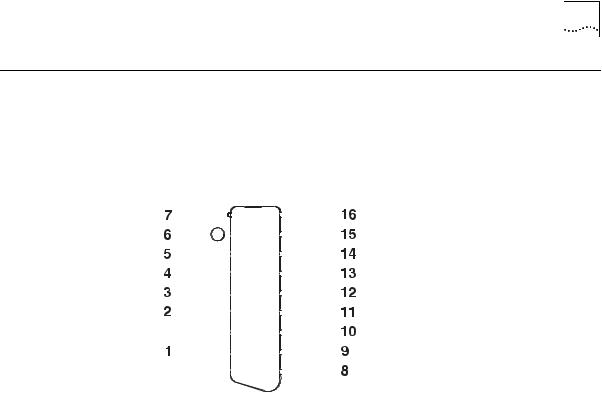
Programmable Access Buttons |
21 |
Programmable |
Figure 2 shows the 18 programmable Access buttons on the NBX 3102 |
||||||
Access Buttons |
Business Telephone. To view or change the current features on your |
||||||
|
telephone’s buttons (button mappings), click the Shortcut to |
||||||
|
One-Touch Speed Dials icon below any NBX NetSet utility screen. Click |
||||||
|
the Help button for instructions. |
||||||
|
Figure 2 3102 Access Buttons |
||||||
|
|
|
|
|
|
|
|
|
|
|
|
|
|
|
|
|
|
|
|
|
|
|
|
|
|
|
|
|
|
|
|
|
|
|
|
|
|
|
|
|
|
|
|
|
|
|
|
|
|
|
|
|
|
|
|
|
|
|
|
|
|
|
|
|
|
|
|
|
|
|
|
|
|
|
|
|
|
|
|
|
|
|
|
|
|
|
|
Access buttons have these default settings, which your administrator can change:
1In most circumstances, your administrator designates these three system appearance buttons as lines for incoming and outgoing calls.
2Personal Speed Dial 1. See “Speed Dials” in Chapter 8.
3Personal Speed Dial 2
4Personal Speed Dial 3
5Call Park button — Allows you to place a call in a “holding pattern” so that it can be retrieved from any other telephone on the system. See “Call Park” in Chapter 9.
6Transfer to Voice Mail button — Sends a call directly to another user’s voice mailbox. See “Direct Mail Transfer” in Chapter 9.
7Feature button — Allows you to access features that are not directly assigned to an Access button on your telephone. See the NBX Feature Codes Guide in the NBX NetSet utility for a list of features and codes and how to use them.
8Release button — Disconnects calls. Useful when you use a telephone headset. See “Using a Headset” in Chapter 8.

22 CHAPTER 2: NBX 3102 BUSINESS TELEPHONE
9Personal Speed Dial 4. See “Speed Dials” in Chapter 8.
10Personal Speed Dial 5
11Personal Speed Dial 6
12Personal Speed Dial 7
13Personal Speed Dial 8
14Personal Speed Dial 9
15Personal Speed Dial 10
16Headset — Press this button to enable the use of a headset that is connected to the telephone.
Status Lights for |
An Access button that is set up for incoming and outgoing calls is called a |
System Appearance |
System Appearance button. The light beside each System Appearance |
Buttons |
button indicates the status. See Table 6. |
|
Table 6 Status Indicator Lights for System Appearance Buttons |
If the light is |
The line is |
|
|
Off |
Available for use |
|
|
Steady |
In use |
|
|
Blinking quickly |
Ringing |
|
|
Blinking slowly |
On hold |
|
|

NBX 1102, 2102,
3 AND 2102-IR BUSINESS
TELEPHONES
This chapter describes the buttons, controls, and features on the following NBX telephones:
■NBX 1102 Business Telephone
■NBX 2102 Business Telephone
■NBX 2102-IR Business Telephone
The chapter covers these topics:
■Telephone Buttons and Controls
■Programmable Access Buttons
■Status Lights for System Appearance Buttons
For a description of the features on the NBX 3102 Business Telephone, see Chapter 2.
For a description of the features on the NBX 3101 and 3101SP Basic
Telephones, see Chapter 4.
For a description of the features on the NBX 2101 Basic Telephone, see
Chapter 5.
For how these features work on an analog telephone that is connected to the NBX system, click the NBX Feature Codes Guide icon below any screen in the NBX NetSet utility.
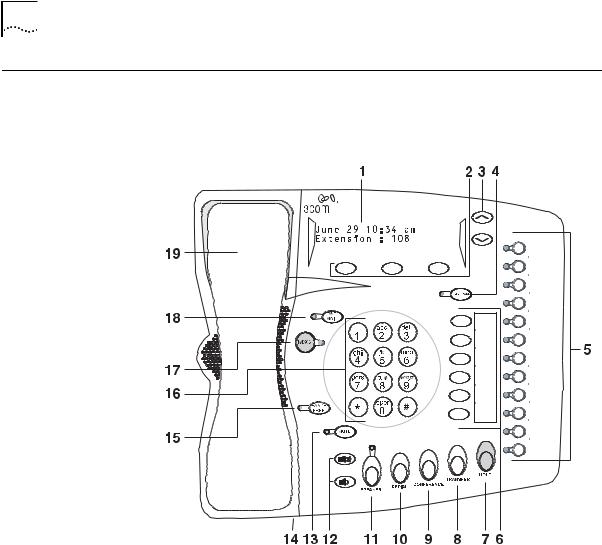
24 CHAPTER 3: NBX 1102, 2102, AND 2102-IR BUSINESS TELEPHONES
Telephone Buttons |
Figure 3 shows the buttons and controls on the NBX 1102, 2102 and |
|||||||||||||
and Controls |
2102-IR Business Telephones. |
|||||||||||||
|
Figure 3 NBX Business Telephone (2102-IR Shown) |
|||||||||||||
|
|
|
|
|
|
|
|
|
|
|
|
|
|
|
|
|
|
|
|
|
|
|
|
|
|
|
|
|
|
|
|
|
|
|
|
|
|
|
|
|
|
|
|
|
|
|
|
|
|
|
|
|
|
|
|
|
|
|
|
|
|
|
|
|
|
|
|
|
|
|
|
|
|
|
|
|
|
|
|
|
|
|
|
|
|
|
|
|
|
|
|
|
|
|
|
|
|
|
|
|
|
|
|
|
|
|
|
|
|
|
|
|
|
|
|
|
|
|
|
|
|
|
|
|
|
|
|
|
|
|
|
|
|
|
|
|
|
|
|
|
|
|
|
|
|
|
|
|
|
|
|
|
|
|
|
|
|
|
|
|
|
|
|
|
|
|
|
|
|
|
|
|
|
|
|
|
|
|
|
|
|
|
|
|
|
|
|
|
|
|
|
|
|
|
|
|
|
|
|
|
|
|
|
|
|
|
|
|
|
|
|
|
|
|
|
|
|
|
|
|
|
|
|
|
|
|
|
|
|
|
|
|
|
|
|
|
|
|
|
|
|
|
|
|
|
|
|
|
|
|
|
|
|
|
|
|
|
|
|
|
|
|
|
|
|
|
|
|
|
|
|
|
|
|
|
|
|
|
|
|
|
|
|
|
|
|
|
|
|
|
|
|
|
|
|
|
|
|
|
|
|
|
|
|
|
|
|
|
|
|
|
|
|
|
|
|
|
|
|
|
|
|
|
|
|
|
|
|
|
1Display panel — Displays telephone status messages, Caller ID information (if enabled), and the number of messages that you have in your voice mail mailbox. You can also use it to view these items:
■Logs of your recent missed, answered, and dialed calls
■A directory of people’s names in your organization
■Personal speed dial numbers
■System-wide speed dial numbers
2Soft buttons — Allow you to select items that are displayed in the telephone display panel. See “Using the NBX Telephone Display Panel” in Chapter 7.

Telephone Buttons and Controls |
25 |
The soft buttons, from left to right, are:
■Slct (Select)
■Back (returns you to the next higher level in the menu)
■Exit (leaves the display panel menus)
3Scroll buttons (Up, Down) — Allow you to scroll through the items in the telephone display panel. See “Using the NBX Telephone
Display Panel” in Chapter 7.
4Program button — Reserved for future use.
5Programmable Access buttons and label area — Allow you and your administrator to assign features to specific buttons. See “Programmable Access Buttons” and “Status Lights for System Appearance Buttons” later in this chapter.
6Programmable Access and label area — Allow you and your administrator to assign features to specific buttons. See “Programmable Access Buttons” later in this chapter.
7Hold button — Places a caller on hold. See “Putting a Call on Hold” in Chapter 7.
8Transfer button — Sends the currently active call to another telephone. See “Transferring a Call” in Chapter 7.
9Conference button — Establishes a single call with up to three additional internal parties, external parties, or both. See “Establishing a Conference Call” in Chapter 7.
10Redial button — Redials the last telephone number or extension that you called. See “Redialing a Call” in Chapter 7.
11Speaker button — Enables you to use the speaker phone feature. Press the Speaker button before you dial the call, when your telephone is ringing, or while a call is in progress. To turn the speaker phone off and resume the conversation, pick up the handset.
12Volume up and down buttons — Raises and lowers the volume of the ringer, the speaker, the handset, or the headset. See “Setting the Volume” in Chapter 7.
13Mute button — Enables you to prevent callers from hearing what you are saying during a telephone call. Press the Mute button to turn off the telephone’s microphone when you are using the handset or when your telephone is in speaker phone mode. To turn off the Mute feature, press the Mute button again.

26 CHAPTER 3: NBX 1102, 2102, AND 2102-IR BUSINESS TELEPHONES
14Infrared Port (2102-IR only) — Receives infrared signals from a hand-held device running the Palm Operating System. See “Palm Integration” in Chapter 8.
15Hands Free button — Allows you to answer internal (intercom) calls without picking up the handset. To activate this feature, press the Hands Free button before calls come in to your telephone. When this feature is enabled, the indicator is lit. When you receive an internal call, your telephone sounds a tone and activates the speaker phone.
An external call (a call from outside your NBX system) rings to your telephone as usual.
16Telephone key pad
17MSG (Message) button — Accesses your voice mail messages through the NBX Messaging system. See “Listening to NBX Messages” in Chapter 6. The status light beside this button acts as a message waiting indicator (you have one or more messages in your voice mailbox).
18FWD MAIL (Forward to Voice Mail) button — Directs all incoming calls to your voice mail (or to wherever you have specified in NetSet > User Information > Call Forward) after one ring. See “Forwarding Incoming Calls to Your Call Coverage Point” in Chapter 6.
19Handset
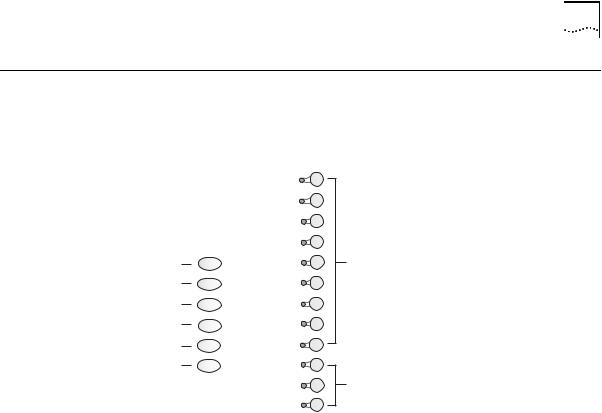
Programmable Access Buttons |
27 |
Programmable |
Figure 4 displays the 18 programmable Access buttons. The One-Touch |
Access Buttons |
Speed Dials screen in the NBX NetSet utility shows your telephone’s |
|
current button mappings. |
|
Figure 4 Access Buttons on NBX 1102, 2102, and 2102-IR Telephones |
1 |
7 |
2
3
4
5
6
8
Access buttons have these default settings, which your administrator can change:
1Feature button — Allows you to access features that are not directly assigned to an Access button on your telephone. See the NBX Feature Codes Guide in the NBX NetSet utility for a list of features and codes.
2Direct Mail Transfer button — Sends a call directly to another user’s voice mailbox. See “Direct Mail Transfer” in Chapter 9.
3Call Park button — Allows you to place a call in a “holding pattern” so that it can be retrieved from any other telephone on the system. See “Call Park” in Chapter 9.
4Flash button (analog line only) — Toggles the current call to another call if the line has the Call Waiting service from your local telephone company, or enables call transfer if the line has the Call Transfer service.
5Unassigned — This button has no default assigned function.
6Release button — Disconnects calls. Useful when you use a telephone headset. See “Using a Headset” in Chapter 8.

28 CHAPTER 3: NBX 1102, 2102, AND 2102-IR BUSINESS TELEPHONES
7Typically, you can use these nine buttons for personal speed dial settings, although the administrator can map them to other features. See “Speed Dials” in Chapter 8.
8In most circumstances, your administrator designates these three system appearance buttons as lines for incoming and outgoing calls.
Status Lights for |
An Access button that is set up for incoming and outgoing calls is called a |
System Appearance |
System Appearance button. The light beside each System Appearance |
Buttons |
button indicates the status. See Table 7. |
|
Table 7 Status Indicator Lights for System Appearance Buttons |
If the light is |
The line is |
|
|
Off |
Available for use |
|
|
Steady |
In use |
|
|
Blinking quickly |
Ringing |
|
|
Blinking slowly |
On hold |
|
|
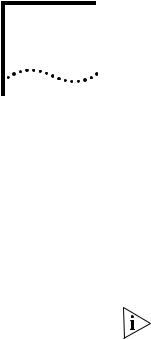
NBX 3101 AND 3101SP BASIC
4 TELEPHONES
This chapter describes the buttons, controls, and features on the NBX 3101 and 3101SP Basic Telephones.
The chapter covers these topics:
■Telephone Buttons and Controls
■Programmable Access Buttons
■Status Lights for System Appearance Buttons
For a description of the features on the NBX 3102 Business Telephone, see Chapter 2.
For a description of the features on the NBX 1102, 2102, and 2102-IR
Business Telephones, see Chapter 3.
For a description of the features on the NBX 2101 Basic Telephone, see
Chapter 5.
For how these features work on an analog telephone that is connected to the NBX system, click the NBX Feature Codes Guide icon below any screen in the NBX NetSet utility.
The NBX 3101 Basic Telephone (3C10401A) does not include a microphone, which means it does not support speaker phone operation. The NBX 3101SP Basic Telephone (3C10410SPKRA) has a microphone and supports speaker phone operation. All other features operate the same on the two telephones.
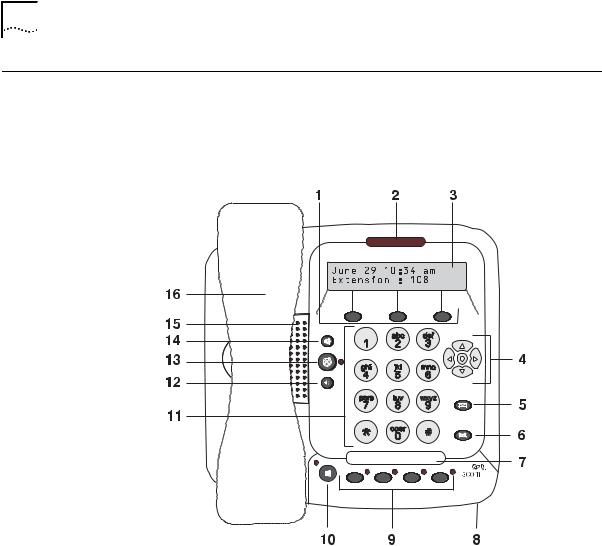
30 CHAPTER 4: NBX 3101 AND 3101SP BASIC TELEPHONES
Telephone Buttons Figure 5 shows the buttons and controls on the NBX 3101SP Basic and Controls Telephone. The NBX 3101 Basic Telephone does not include a
microphone, 8, or a speaker button and its indicator light, 10. All other controls are identical on the two telephones.
Figure 5 NBX 3101SP Basic Telephone
1Soft buttons — Allow you to select items that are displayed in the telephone display panel. See “Using the NBX Telephone Display Panel” in Chapter 7. The buttons, from left to right, are:
■Slct (Select)
■Back (returns you to the next higher level in the menu)
■Exit (leaves the display panel menus)
2Message Waiting Indicator (MWI) — When lit, indicates that you have one or more new voice mail messages in your voice mailbox. Also, this indicator flashes when your telephone rings.
